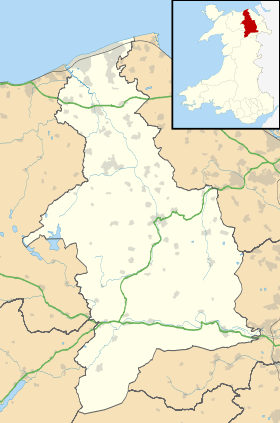Efenechtyd
| Efenechtyd | |
| St Michael and All Angels |
|
 Efenechtyd |
|
| Population | 655 (2011)[1] |
|---|---|
| OS grid reference | SJ115555 |
| Community | Efenechtyd |
| Principal area | Denbighshire |
| Country | Wales |
| Sovereign state | United Kingdom |
| Post town | RUTHIN |
| Postcode district | LL15 |
| Dialling code | 01824 |
| Police | North Wales |
| Fire | North Wales |
| Ambulance | Welsh |
| EU Parliament | Wales |
| UK Parliament | Clwyd West |
| Welsh Assembly | Clwyd West |
|
|
Coordinates: 53°05′28″N 3°19′41″W / 53.091°N 3.328°W
Efenechtyd is a hamlet in deep and remote valley in Denbighshire, Wales which contains the Church of St Michael and All Angels.
Governance
An electoral ward of the same name exists. This ward stretches to the south-west of Efenechtyd with a total population taken at the 2011 census of 1,686.[2]
Church of St Michael and All Angels
Set amid a cluster of old houses in a deep and remote valley, St Michael’s is the tiny church of a pretty hamlet. Its circular yew-grown churchyard is a sign of Celtic origins, and the first church here may have been founded by monks from St Saeran’s community at Llanynys (Site 46): the name Efenechtyd could mean ‘place of the monks’. The present building – twenty feet wide, and the second smallest church in the diocese of St Asaph – probably dates from the 13th century, but was extensively restored in 1873.
The ancient door with its spur-shaped iron knocker leads to a simple and very peaceful interior. Its most remarkable treasure is the rare medieval wooden font, a single circular oak block hewn with fourteen facets over a ring of beading: it is probably a 15th or 16th-century local copy of the stone fonts then fashionable. The low battlemented rail nearer the altar is also late medieval, and part of a rood screen (see Derwen Site 6), but the east window is older and perhaps of c. 1300.
Notable later features include a rare fragment of a Welsh wall-painted Ten Commandments (doubtless Elizabethan or Jacobean) and a painted timber monument to Catherine Lloyd (1810), with cherubs and skull and cross-bones. The Georgian monument to Joseph Conway displays his family crest of 'a blackamoor's head': similar heads adorn the gateposts of his (private) house, Plas-yn-Llan, a short step from the churchyard gate. The rounded stone by the font is the ‘Maen Camp’, formerly used at the local ‘campau’ (‘Sports’) on St. Michael’s Day, 29 September. Village Samsons strove to hurl it backwards over their heads.[3]
The custom of throwing the Feat Stone has been revived in recent years and takes place at the Harvest Festival celebrations.[4]
The church is generally open for visitors.Further information and opening times from Diocesan Office, High Street, St Asaph, LL17 0RD; Phone number: 01745 582245.[5]
- Church of St Michael and All Angels
- Font, carved from one piece of wood
- Carved roode and pulpit
- Roof beams
- Back of church
References
| Wikimedia Commons has media related to Efenechtyd. |
- ↑ "Community Population 2011". Retrieved 23 May 2015.
- ↑ "Ward population 2011". Retrieved 23 May 2015.
- ↑ Dr Charles Kightly. Enjoy Medieval Denbighshire. Denbighshire County Council.
- ↑ |accessdate=2013-11-31], Maen Camp 2013
- ↑ , Diocesan Contacts
Living Paths
As of 28 April 2011, this article is derived in whole or in part from medieval-wales.com/index.php. The copyright holder has licensed the content in a manner that permits reuse under CC BY-SA 3.0 and GFDL. All relevant terms must be followed. The original text was at "Efenechtyd".
